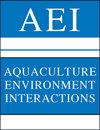由破坏活动引发的大规模逃逸事件造成的鱼群扩散
IF 2.5
2区 农林科学
Q2 FISHERIES
引用次数: 0
摘要
ABSTRACT: 养殖场破坏可导致大规模鱼类逃逸事件,带来重大生态和社会经济风险。本研究考察了地中海鲈鱼(Dicentrarchus labrax)在西地中海发生大规模逃逸事件后的命运。我们监测了逃逸事件发生后 3 个月内逃逸者的密度和体型结构,逃逸地点距离逃逸地点越来越远,最远达 45 公里。破坏事件发生 5 d 后,逃逸地点附近的鱼类密度平均为每 100 m2 114 ± 44.7(SE)条。我们的分析表明,逃逸地点每远离一公里,鱼类密度就会下降 17%,在逃逸事件发生 1 个月和 2 个月后,鱼类密度分别下降到 2%和 1%。随着逃逸者密度在时间和空间上的下降,鲈鱼的体型分布也向大体型转移。鱼类密度的快速下降凸显了制定应急计划的必要性,重点是在逃逸地点附近(20 千米)的沿海地区在最初 24 小时内开展捕捞工作。我们强调预防破坏措施的重要性,例如能够快速检测入侵者并立即做出反应以阻止他们的安全系统。此外,根据造成破坏的严重程度实施适当的制裁也有助于阻止未来的破坏企图。本文章由计算机程序翻译,如有差异,请以英文原文为准。
Fish dispersal from a sabotage-mediated massive escape event
ABSTRACT: Farm sabotage can cause massive fish escape events with significant ecological and socio-economic risks. This study examined the fate of Mediterranean seabass Dicentrarchus labrax escapees following a large-scale escape event caused by sabotage in the Western Mediterranean Sea. We monitored the escapee density and size structure over 3 mo after the escape at increasing distances from the escape point, up to 45 km away. Fish density adjacent to the escape location 5 d after the sabotage was, on average, 114 ± 44.7 (SE) fish per 100 m2. Our analyses showed that fish density decreased by 17% for every km away from the location, dropping to 2 and 1% after 1 and 2 mo, respectively, following the escape event. As escapee density declined throughout time and space, the size distribution of seabass shifted towards larger sizes. The rapid decrease in fish densities highlights the need for contingency plans focusing on fishing efforts in the coastal areas near the escape location (<20 km) within the first 24 h. These results are paramount to mitigating the risks associated with escape events cost-effectively. We emphasise the importance of sabotage prevention measures, such as security systems that can quickly detect intruders and trigger an immediate response to deter them. Additionally, enforcing appropriate sanctions based on the severity of the damage caused could help to discourage future sabotage attempts.
求助全文
通过发布文献求助,成功后即可免费获取论文全文。
去求助
来源期刊

Aquaculture Environment Interactions
FISHERIES-MARINE & FRESHWATER BIOLOGY
CiteScore
4.90
自引率
13.60%
发文量
15
审稿时长
>12 weeks
期刊介绍:
AEI presents rigorously refereed and carefully selected Research Articles, Reviews and Notes, as well as Comments/Reply Comments (for details see MEPS 228:1), Theme Sections and Opinion Pieces. For details consult the Guidelines for Authors. Papers may be concerned with interactions between aquaculture and the environment from local to ecosystem scales, at all levels of organisation and investigation. Areas covered include:
-Pollution and nutrient inputs; bio-accumulation and impacts of chemical compounds used in aquaculture.
-Effects on benthic and pelagic assemblages or processes that are related to aquaculture activities.
-Interactions of wild fauna (invertebrates, fishes, birds, mammals) with aquaculture activities; genetic impacts on wild populations.
-Parasite and pathogen interactions between farmed and wild stocks.
-Comparisons of the environmental effects of traditional and organic aquaculture.
-Introductions of alien species; escape and intentional releases (seeding) of cultured organisms into the wild.
-Effects of capture-based aquaculture (ranching).
-Interactions of aquaculture installations with biofouling organisms and consequences of biofouling control measures.
-Integrated multi-trophic aquaculture; comparisons of re-circulation and ‘open’ systems.
-Effects of climate change and environmental variability on aquaculture activities.
-Modelling of aquaculture–environment interactions; assessment of carrying capacity.
-Interactions between aquaculture and other industries (e.g. tourism, fisheries, transport).
-Policy and practice of aquaculture regulation directed towards environmental management; site selection, spatial planning, Integrated Coastal Zone Management, and eco-ethics.
 求助内容:
求助内容: 应助结果提醒方式:
应助结果提醒方式:


